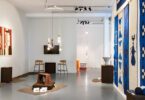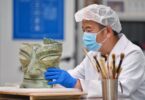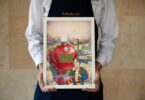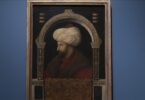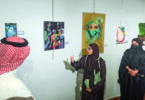Maan Jalal
Sharjah Art Foundation’s latest exhibition invites viewers to explore and reimagine elements of memory and their immediate environment.
Renowned artists Lubaina Himid Magda Stawarska have collaborated across three galleries and the courtyards of Al Mureijah Square to put on a show in their own name.
Lubaina Himid and Magda Stawarska: Plaited Time / Deep Water was prepared over more than four years in collaboration with Omar Kholeif, the foundation’s director of collections and senior curator.
“It made sense to invite them on a journey together and to see how that unfolded,” Kholeif tells The National. “They’re both negotiating how something can look a particular way but actually means something else entirely – or make you feel something else entirely.”
The show has many elements to explore and ponder. One that feels pertinent and poignant is that of memory. Stepping into the collaborative works of the installation, viewers enter an unfolding of thoughts, experiences and voices. Specific memories, time and place meld into one another but leave room for the viewer to navigate and consider their own associations, not only to Sharjah, but to any city and their own experiences.
:quality(70)/cloudfront-eu-central-1.images.arcpublishing.com/thenational/IRFPXX5EU54CIADYFHXK3CSNLU.jpg)
A holistic experience through a show can feel overwhelming. But with two artists of this calibre and Kholeif’s vision, the exhibition feels like a poem – full of nuance and thoughtful gestures.
Himid is an artist, curator, educator and the first black woman to win the Turner Prize. Her work has been instrumental to the British Black Movement in the 1980s. Born in Zanzibar in 1954, her mother moved them to the UK when she was four months old after the death of her father.
Himid works across paintings, installations, exhibition making, sound and writing. Much of her practice delves into issues of race, gender, class and facets of the African diaspora. Her multi-discipline approach through the years has revealed an artist who understands and weaves storytelling into her work as a means through unexpected and sometimes subconscious ways.
“She is one of the most important cultural figures I think that’s ever lived,” Kholeif says. “I invited Lubaina first to do a show because the Arabian Gulf has incredibly long and historical connections to Zanzibar. I thought this would be imperative. It may also be the closest thing she would have to a solo exhibition in Zanzibar itself.”
Stawarska is an artist who explores ideas pertaining to memory through different layers and contexts. She uses a number of mediums, including sound, performance and moving images to explore and examine the past through “inner listening”.
Kholeif explains: “It’s about a collective act of deep listening. And inner listening is about how we enter inside the skin of fabric of a cityscape and typography.”
Long-time collaborators, Himid and Stawarska work in partnership and individually. Their works repurpose and reimagine objects, symbols and fragments of experiences into installations for viewers to observe and connect.
One example is Zanzibar. It is an honest, immersive piece that in many ways is the anchor of the exhibition. The series of paintings depicts several stages of Himid’s life experiences through the concept of returning.
This includes her migration from Zanzibar to the UK and back. Intricately painted geometric shapes feel flat, stationary and hollow, yet float against a background of delicately dripping and stained paint marks.
:quality(70)/cloudfront-eu-central-1.images.arcpublishing.com/thenational/KUA7C7X4ERG73BL5CIDNNASKXY.jpg)
The paintings have now been repurposed into a multisensory installation for the exhibition. Stawarska removed them from the wall and hung them through the space so they speak to each other and the viewer within an immersive sound environment.
From references to midcentury British life to Hamid’s favourite operas played in fragments from the BBC archives, the sound element to Zanzibar interplays with the paintings and invites viewers to linger through the work and make their own connections.
Zanzibar feels like floating memories, cascading and echoing through the space – an effect that is particularly poignant when hearing Himid’s voice too.
“Although the works are abstractions, it’s very much figurative because it’s the first time that you ever hear Lubaina Hamid’s voice talking about herself,” Kholeif says.
“She’s grieving over the death of her father. You sense this longing in her voice for a father or what it might have meant to have a father or what would have been different had he lived.”
:quality(70)/cloudfront-eu-central-1.images.arcpublishing.com/thenational/6WLSM52NY5FAPIGH6OUEA5ZLWU.jpg)
Memory is a powerful theme running through other aspects of the exhibition too. In Patterns of Al-Andalus, Stawarska took patterns she saw fading in the streets of Sharjah and brought them back to life by screen printing on long sheets, hanging them through the space and then projecting images of the emirate over them. The effect reconstructs the city in a way no words can. It’s a recollection of memories and histories pulsating through the city itself.
Then there is an intimate work by Himid, a mixed-media installation entitled Secret Study that is produced specifically for the exhibition. Items from Himid’s private collection of personal artworks, done by her and others, share the space with archival material, mementoes and more.
Viewers can observe this corner of her studio, a space that feels very much lived in, and yet existing in the gallery. It also offers a peak into Himid’s inner world with indicators of how she works, thinks and collects as a practitioner.
“My mission with this show is to say that, to create the perfect painting takes a lifetime of knowledge and experience – but it’s also something that you have to keep trying with,” Kholeif says.
Courtesy: thenationalnews



